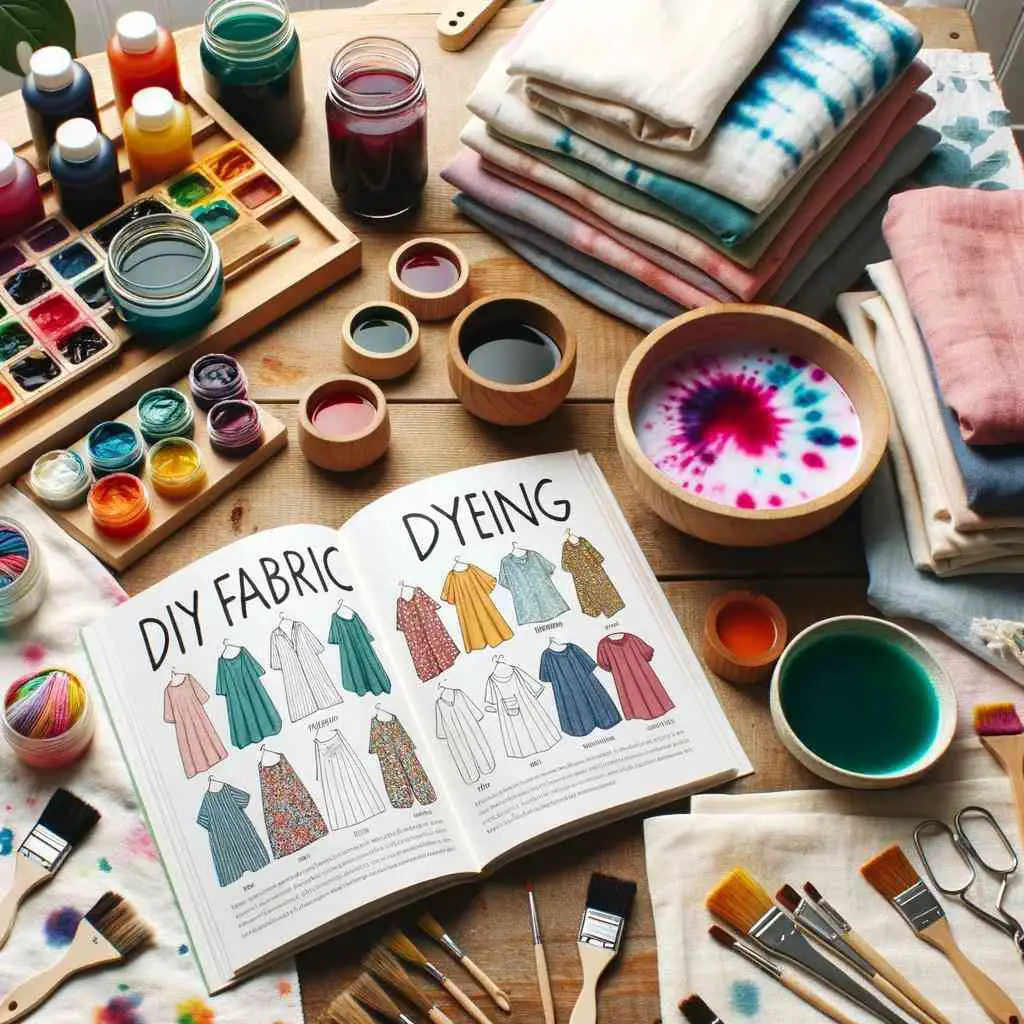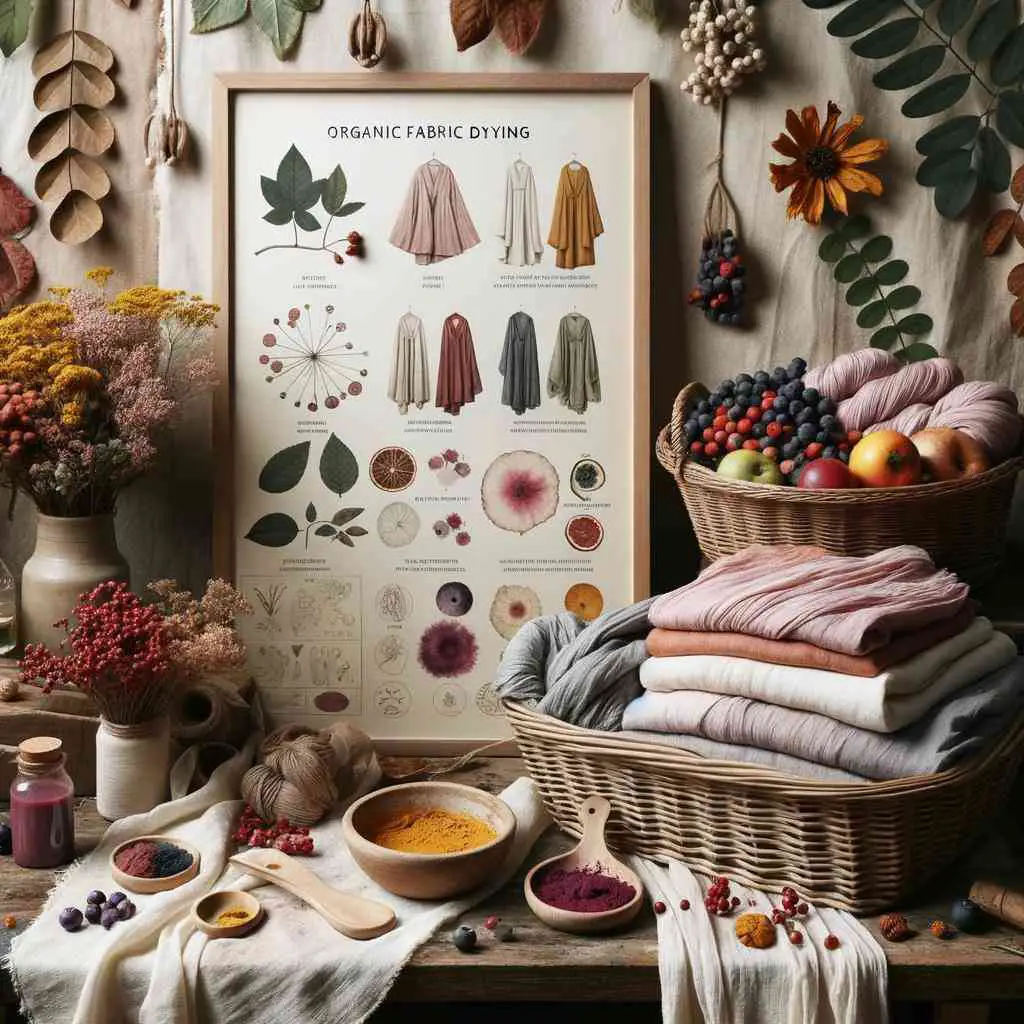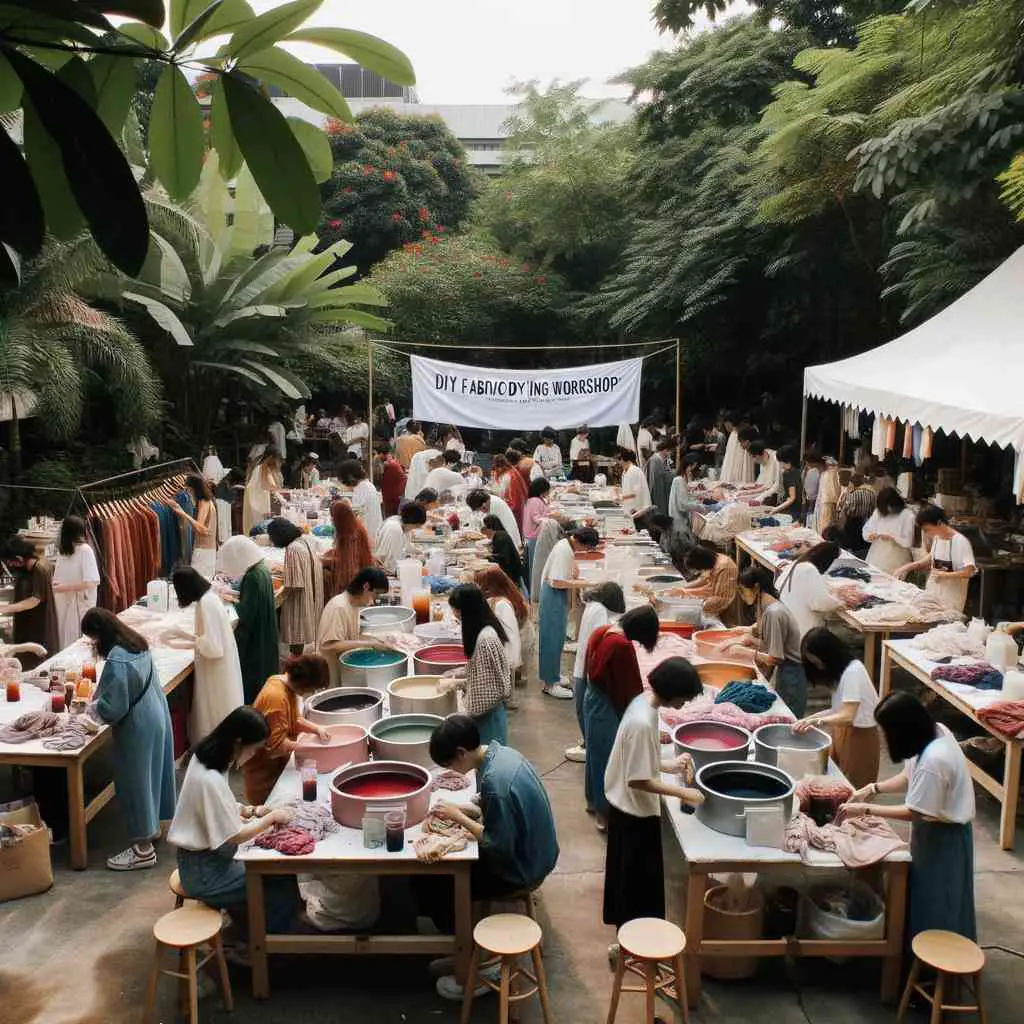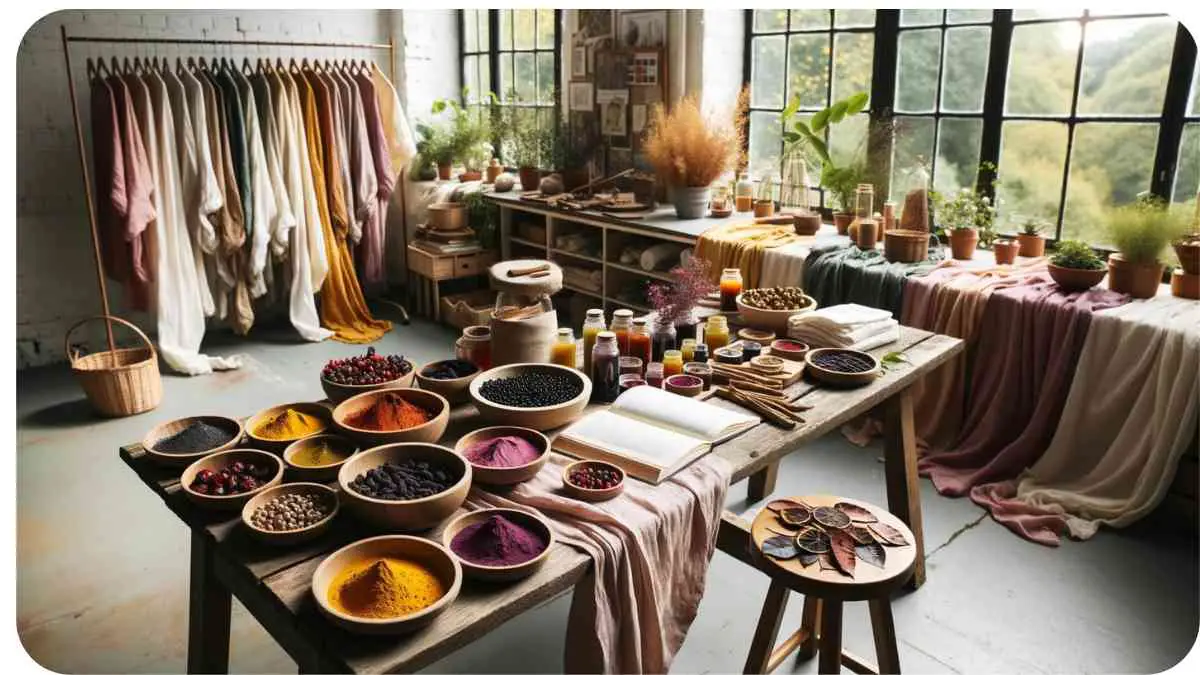Welcome to the world of DIY fabric dyeing! Whether you’re looking to refresh your old clothes or create custom-designed fabrics, this comprehensive guide will walk you through the process step by step. Fabric dyeing is a creative and rewarding craft that allows you to add a personal touch to your wardrobe or home decor.
In this guide, I’ll share my expertise and personal experiences in fabric dyeing to help you become a proficient fabric dyer. By the end of this article, you’ll have the knowledge and confidence to embark on your dyeing adventures.
| Key Takeaways |
|---|
| 1. Choose the right fabric for dyeing. |
| 2. Select the appropriate type of dye. |
| 3. Pre-treat and prepare your fabric. |
| 4. Explore various dyeing techniques. |
| 5. Properly mix and apply the dye. |
| 6. Set the dye to make it colorfast. |
| 7. Rinse, wash, and care for dyed fabrics. |
| 8. Troubleshoot common dyeing issues. |
| 9. Prioritize safety precautions. |
| 10. Embrace sustainability in dyeing. |
| 11. Find inspiration in success stories. |
| 12. Enjoy the creative journey of fabric dyeing. |
2. Getting Started
2.1 Choosing the Right Fabric
Before you start dyeing, it’s crucial to select the right fabric. Different fabrics absorb dye differently, so consider the material you’re working with. For example, natural fibers like cotton, linen, and silk take dye well, while synthetics may require special dyes.
Are you passionate about crafting? Discover the art of fabric dyeing with our comprehensive guide. Dive into a world of color and creativity, transforming plain fabrics into stunning works of art. Explore techniques, tips, and inspiration to elevate your DIY projects.
2.2 Selecting the Dye
Choosing the right dye is equally important. There are various types of fabric dyes available, including fiber-reactive, direct, and acid dyes. Your choice of dye will depend on the fabric you’re dyeing and the effect you want to achieve.
2.3 Gathering Supplies
To ensure a smooth dyeing process, gather all the necessary supplies, including gloves, apron, containers for dye mixing, and stirring utensils. Having everything ready beforehand will make the process more efficient.
3. Preparing Your Workspace

Set up a dedicated workspace for fabric dyeing. Cover surfaces with plastic sheets or old newspapers to protect them from dye spills. Adequate ventilation is essential when working with dyes, so consider working outdoors or in a well-ventilated area.
4. Pre-Treatment of Fabric
4.1 Washing
Before dyeing, wash your fabric to remove any dirt, oils, or sizing. Use a mild detergent and avoid using fabric softeners, as they can interfere with dye absorption.
Crafting enthusiasts, elevate your skills with our guide to scrapbooking supplies. From paper to dye, it’s all about creativity. If you’re curious about fabric dyeing, our comprehensive guide will help you master the art.
4.2 Pre-soaking
Pre-soaking the fabric in warm water ensures even dye penetration. Depending on the fabric type, soak it for 15 minutes to an hour. Squeeze out excess water before dyeing.
Continue writing about pre-soaking techniques and share any personal tips on this step.
5. Dyeing Techniques
Fabric dyeing offers various techniques to achieve different results. Let’s explore some popular methods:
5.1 Immersion Dyeing
Immersion dyeing involves submerging the entire fabric in a dye bath. This technique is versatile and can be used for single-color or multi-color dyeing.
5.1.1 Single Color Immersion
For a single-color dye job, prepare a concentrated dye bath and immerse the fabric, stirring occasionally. The longer you leave it in the dye, the deeper the color will be.
5.1.2 Multi-Color Immersion
To create beautiful multi-color effects, submerge different sections of the fabric in separate dye baths. This technique allows for creative color blending.
Add a table illustrating the steps for single color immersion dyeing.
| Steps for Single Color Immersion Dyeing |
| 1. Prepare the dye bath |
| 2. Immerse the fabric |
| 3. Stir occasionally |
| 4. Rinse and wash the fabric |
| 5. Set the dye as per instructions |
Continue explaining multi-color immersion dyeing and share your expertise in achieving vibrant color combinations.
Looking for fresh crafting ideas? Step into the world of paper mache projects. Unleash your creativity and discover how this technique can complement your love for fabric dyeing. Dive into imaginative DIY crafts today!
6. Mixing and Applying Dye

The key to successful fabric dyeing is in the dye mixture. Follow the manufacturer’s instructions to mix the dye, and be precise with measurements. Apply the dye evenly using brushes, squeeze bottles, or other applicators, depending on your chosen technique.
Add a table with recommended dye mixing ratios for common fabric types.
| Fabric Type | Dye Mixing Ratio |
| Cotton | 1:1 |
| Silk | 1:2 |
| Linen | 1:1 |
| Wool | 1:3 |
Share your insights on the importance of proper dye application and your personal experiences with dye mixing.
7. Setting the Dye
Once you’ve applied the dye, it’s essential to set it to ensure it becomes colorfast and won’t wash out. There are two primary methods for setting dye:
Crafting is a journey of creativity. Whether you’re into card making or fabric dyeing, our comprehensive guide will provide you with tips and tricks to enhance your skills. Explore a world of possibilities.
7.1 Heat Setting
Heat setting involves exposing the dyed fabric to high temperatures, usually through ironing or using a clothes dryer. Follow the specific temperature and duration recommendations provided with your dye.
7.2 Cold Setting
Some dyes, like fiber-reactive dyes, require cold setting. This process involves wrapping the dyed fabric in plastic and letting it sit for a specified period. Cold setting is a slower but effective method for colorfastness.
Add a table comparing heat setting and cold setting methods, including recommended times and temperatures for various dyes.
| Setting Method | Suitable Dyes | Temperature (°C) | Duration (Minutes) |
| Heat Setting | Direct, Acid | 150-160 | 3-5 |
| Cold Setting | Fiber-Reactive | Room Temperature | 12-24 |
8. Rinsing and Washing
After setting the dye, rinse the fabric thoroughly to remove excess dye. Gradually reduce the water temperature to avoid color bleeding. Once the water runs clear, wash the fabric with a mild detergent to remove any remaining dye particles.
Share your personal tips for effective rinsing and washing, including any challenges you’ve encountered and overcome in this step.
9. Caring for Dyed Fabrics
Proper care is essential to maintain the vibrancy of dyed fabrics. Always follow the care instructions for the fabric type, and avoid using harsh detergents or bleach, as they can fade the colors. Washing your dyed items in cold water will help preserve the colors.
Crafting on a budget? We’ve got you covered with cost-effective paper crafts ideas. Discover how to save money while pursuing your passion, including the fascinating world of fabric dyeing. Get creative without breaking the bank!
10. Troubleshooting Common Issues
Dyeing may come with challenges like uneven color distribution or color bleeding. I’ve faced my fair share of issues and have learned how to troubleshoot them. Here are some common problems and solutions:
- Uneven Color: Stir the dye bath consistently and ensure the fabric is fully submerged.
- Color Bleeding: Use a fixative like salt or vinegar during dyeing to help set the color.
- Fading: Avoid exposure to direct sunlight, which can fade dyed fabrics over time.
Create a table summarizing common dyeing issues and their solutions.
| Issue | Solution |
| Uneven Color | Stir dye bath, ensure full submersion |
| Color Bleeding | Use fixatives like salt or vinegar |
| Fading | Avoid direct sunlight exposure |
Share more troubleshooting tips and your personal experiences in resolving dyeing issues.
11. Safety Precautions
Dyeing involves working with chemicals, so safety is paramount. Always wear protective gear like gloves and an apron. Work in a well-ventilated area, and keep dyes and chemicals out of reach of children and pets.
12. Tips and Tricks
Throughout my fabric dyeing journey, I’ve picked up some valuable tips and tricks that can make the process smoother and more enjoyable. Here are a few:
- Experiment: Don’t be afraid to try new techniques and color combinations.
- Keep Records: Note down your dye mixtures and techniques for future reference.
- Test Swatches: Always test your dye colors on small fabric swatches before dyeing the entire piece.
Create a table with additional fabric dyeing tips and tricks.
| Tip | Description |
| Experiment | Try new techniques and color combinations |
| Keep Records | Document dye mixtures and techniques for reference |
| Test Swatches | Always perform dye tests on small fabric swatches |
13. Sustainability in Fabric Dyeing

As a responsible fabric dyer, consider the environmental impact of your craft. Here are some eco-friendly practices to incorporate into your dyeing process:
- Natural Dyes: Explore the world of natural dyes, which are derived from plants and other organic sources.
- Water Conservation: Minimize water usage by reusing dye baths for multiple projects.
- Safe Disposal: Dispose of leftover dyes and chemicals properly, following local regulations.
C – Share your experiences with sustainable dyeing practices and any insights on how to reduce the environmental footprint of fabric dyeing.
14. Personal Success Stories
Fabric dyeing can lead to stunning and unique results. Let me share a couple of my personal success stories:
- Tie-Dye Masterpiece: I once created a tie-dye shirt with vibrant, swirling colors that received countless compliments.
- Reviving Old Fabrics: I transformed faded and worn-out pillowcases into vibrant, like-new decor pieces.
Create a table summarizing your personal fabric dyeing success stories and the key takeaways from each.
| Success Story | Key Takeaway |
| Tie-Dye Masterpiece | Creativity knows no bounds in fabric dyeing |
| Reviving Old Fabrics | Dyeing can breathe new life into old items |
Continue sharing more of your personal fabric dyeing experiences and insights.
15. Conclusion
In this comprehensive guide, we’ve explored the exciting world of DIY fabric dyeing. You’ve learned how to choose the right fabric, select dyes, and master various dyeing techniques. We’ve covered crucial steps like mixing and setting dyes, troubleshooting common issues, and practicing safety precautions.
Remember that fabric dyeing is both an art and a science. With practice and patience, you’ll develop your expertise and create beautiful, one-of-a-kind pieces. Whether you’re refreshing your wardrobe or adding a personal touch to your home decor, fabric dyeing is a versatile and rewarding craft.
So, don’t hesitate to dive in and let your creativity flow. Embrace the colors, experiment with techniques, and enjoy the journey of turning plain fabrics into vibrant works of art. Happy dyeing!
Further Reading
- Martha Stewart: Fit to Be Dyed
- Explore Martha Stewart’s expert insights on fabric dyeing techniques and creative projects.
- Skillshare: A Guide to Natural Dyes
- Learn how to create fabric dyes using natural ingredients from Skillshare’s comprehensive guide.
- MasterClass: How to Dye Fabric
- Discover professional tips and techniques for fabric dyeing with MasterClass.
FAQs
How do I choose the right fabric for dyeing?
Select fabrics made of natural fibers like cotton, linen, or silk, as they take dye well. Avoid synthetics unless using specialized dyes.
What types of dyes are suitable for fabric dyeing?
Different dyes, such as fiber-reactive, direct, and acid dyes, are suitable for various fabrics. Choose the one that best matches your project.
Can I use items from my kitchen to create natural dyes?
Yes, you can use food and plant-based ingredients to make natural dyes. Experiment with items like fruits, vegetables, and spices.
What’s the best way to set fabric dye?
The method for setting fabric dye depends on the type of dye you’re using. Heat setting and cold setting are common methods. Follow the manufacturer’s recommendations.
How can I prevent color bleeding in my dyed fabrics?
To prevent color bleeding, use fixatives like salt or vinegar during the dyeing process. Additionally, wash dyed fabrics separately until excess dye is removed.

Hellen James is the creator of Unified Crafts and has been crafting since she was a kid accompanied by her mom to the craft store, where she was free to choose whatever ignited her imagination.

